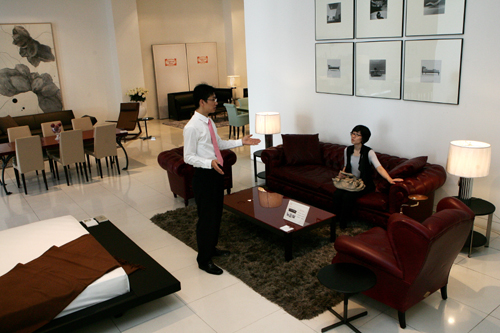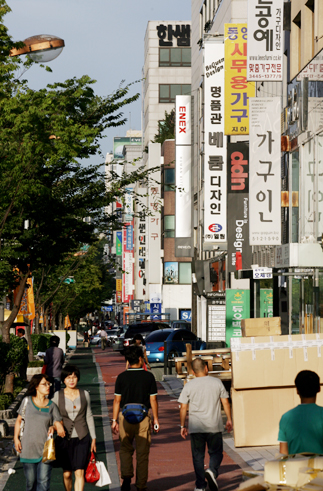Plains turn into a furniture mecca

Hankook Furniture at Nonhyeon, southern Seoul, sells luxury European furniture. The retailer caters to high-end customers. By Jeon Min-kyu
With Gangnam evolving into Korea’s trend-setting epicenter during the past three decades, the furniture street in Nonhyeon-dong has become a mecca for stylish furniture.

Nonhyeon Furniture Street is a 2-kilometer boulevard lined on both sides with some 100 shops. By Jeon Min-kyu
Both sides of a boulevard stretching 2 kilometers (1.2 miles) from Nonhyeon to Hakdong stations on Subway line No. 7 are lined with almost 100 shops offering not only furniture but also a range of home decor items and accessories including lighting, fabrics and tiles. And from Hakdong, a road begins where construction material shops are scattered. This is why people setting up house are advised, “Go to Nonhyeon for furniture and to Hakdong for building materials.”
The Nonhyeon furniture district houses virtually every furniture brand in existence - both local and foreign - and the price differences among the products, from modern to antique, can be extreme.
Some high-end retailers, such as Hankook Furniture and DISAmobili, have an exclusive distribution contract with world-class brands like Poltrona Frau and Potocco. Contracts have also been signed with prolific designers such as Philippe Starck, Karim Rashid and Arik Levy. Naturally, price tags on some limited-edition pieces amount to tens of millions of won that only high-income earners can afford. As the need escalates to cater to these customers with deep pockets and picky tastes, it has become the latest fashion among certain shops to take on the look of an art gallery rather than a retail outlet.
These shops have only a small number of visitors. Often only a few customers, usually a mother and daughter, are observed in individual shops.
“Customers usually make an appointment before visiting. They are fond of such exclusivity and don’t want to be bothered by other customers,” said Lee Eun-kyoung, manager of Poltrona Frau brand at Hankook Furniture.
Choi Hye-in, in her early 30s, was on a half-day tour of the street with her mother and a brother to shop for furniture for a recently remodeled home.
“We came to look for a made-in-From Italy marble table. I know imports are expensive but their design and quality are excellent compared with domestic counterparts,” she said.

The area has discount outlets for local brands like Ace Bed and Borneo International Furniture. Some shops run by individual furniture designers and even a store solely devoted to Korean traditional lacquered works originating from the region of Tongyeong, or “Tongyeong Chilgi,” is located in the district.
Hanssem, the country’s top furniture maker, and ENEX, a Korean brand specializing in kitchen furniture and equipment, also have huge outlets in the area. And at mass producers and distributors such as Gaguin, which mostly deals with wholesalers, individual customers can buy chairs and sofas at much lower cost than at regular retailers.
Some stores sell designer-lookalikes. However, their materials and quality are not the same.
Still, imports define the neighborhood.
What distinguishes Nonhyeon from other districts renowned for furniture, such as Ahyeon and Insa in central Seoul and Sadang in western Seoul, is that imports account for more than 70 percent of the products sold there.
“As the Seoul government pushed urban redevelopment projects in southern Seoul in the early 1980s and the area suddenly exploded with people from all around the city moving into the new town, high-end furniture producers proliferated,” said Lee Myeong-seob, director of planning and coordination at Young Dong Furniture. At the initial stage of relocation, the mainstream of the furniture street was domestic producers of pricey, high quality furniture. But the landscape changed about a decade ago as the price competitiveness of locally manufactured products began fading.
Young Dong was launched as a local furniture manufacturer 35 years ago, but its product lineup now is entirely made up of imports. The shop turned to mostly Italian and German brands 13 years ago.
“Domestic furniture producers have lost the competitive edge against importers mainly due to mounting material and labor costs and lagging design quality. Importing is a much more efficient choice than producing on our own. Lately the won’s steady decline against the dollar and euro has hiked prices of materials even further,” said Lee.
Has the nation’s economic slowdown dealt a blow to the high-end market?
“Yes, definitely,” he said. That might seem a surprising answer given that luxury products in Korea are booming despite economic conditions. Furnitures are different, said Lee. “The furniture market is highly dependent on the real estate market. Robust real estate activity leads to relocation, remodeling and construction. But now with a frozen realty market everything has stopped.” His remarks partially explain why a fourth to a third of the stores are displaying signs advertising bargains at 45 to 50 percent off. For instance, a mirrored console from Europe originally costing around 3 million won carried a price tag of half that at Rochebois, an import furniture retailer.
Despite such attractive prices, visitors may be easily worn out on an excursion there. Even a random look into a handful of eye-catching shops may require a minimum of four to five hours, but not a single coffee shop or convenience store was in sight on the boulevard. A good idea would be to go into the basement of Hanssem, where a design gallery featuring interiors and kitchen furnishings as well as a cafe was opened last month. A cup of Americano costs only 1,000 won.
By Seo Ji-eun Staff Reporter [spring@joongang.co.kr]










with the Korea JoongAng Daily
To write comments, please log in to one of the accounts.
Standards Board Policy (0/250자)